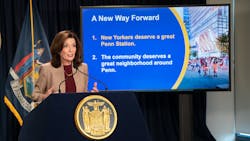Gov. Hochul releases revised plan for New York Penn Station
New York Gov. Kathy Hochul released her revised vision for New York Penn Station on Nov. 3 with a plan she says puts commuters first and will contribute to a more livable city.
The revised plan refines its priority toward renovating rather than expanding NY Penn Station, which may even include a name change with the governor asking a press conference why the busiest hub in the city is named after a neighboring state. But a potential name change is still being explored.
“When I first took office, I knew there were plans, [and] a lot of concerns about a plan that [had] already been announced. There were plans from the local community. I come out of local government. I am hardwired to be responsible to local community desires and needs because those are the people who live there. This is their neighborhood. What we do affects them the most. They need to be heard,” said Gov. Hochul.
She noted 60 percent of station users are New Yorkers and the renovation plan is designed with them in mind, adding “your daily commute should not be a daily grind.”
"I'm reimagining the New York City commuter experience. New Yorkers do not deserve what they have been subjected to for decades at Penn Station," Governor Hochul said. "The era of neglecting our Penn Station commuters and the neighboring community is over. New York leaders are expected to offer visionary ideas and take bold actions, and that's exactly what my proposed transformation of Penn Station accomplishes. This plan puts New Yorkers first, delivering the rider-focused transit experience and great neighborhood they deserve. Investing in Penn Station means investing in New York's future as we recover from COVID and build a more sustainable, livable city."
Gov. Hochul’s plan for NY Penn Station
The governor envisions a four-to-five-year project that will carry costs between $6 and$7 million. The proposal’s main features include a new train facility, improved transit access and shared, pedestrian friendly streets, affordable housing, social services and public space.
The centerpiece of the plan will be a 450-foot single level, double height train hall that will double passenger circulation space, create clear sight lines, simplify navigation and add 18 more escalators or stairs and 11 additional elevators to platforms.
"Penn Station is the busiest transportation facility in the city, with six subway lines, countless bus routes and soon, four railroads and we've been waiting generations for Penn Station to be upgraded. I am thrilled the governor had decided to put an end to decades of delay and is insisting that we fix Penn Station now," said Metropolitan Transportation Authority Acting Chair and CEO Janno Lieber.
The proposal calls for expanding underground corridors and nearly doubling existing entrances. Sidewalks throughout the neighborhood will be widened with protected bike lanes and expanded bike parking. Additionally, the plan recommends 31st, 32nd and 33rd Streets become shared streets that prioritize pedestrians. Pedestrian priority will also be delivered by limiting the size of new building commercial lobbies and requiring that 40 percent of every building frontage serve an “active use” such as retail and community facilities.
Development planned for the surrounding neighborhood has been reduced by 1.4 million square feet, decreases heights for proposed buildings and provides new design controls to protect views of the Empire State Building along 33rd Street.
The proposal will create a Public Realm Task Force to develop a plan of prioritized public realm improvements. The plan includes the addition of approximately eight acres of public space, requires community facility spaces that prioritize social services and create underground loading/unloading for Madison Square Garden, which will take trucks off the street.
“Gov. Hochul's vision for a world-class Penn Station and revitalized surrounding neighborhood will not only enhance the commuter experience for passengers in New York City and the Northeast Corridor, but it will also be a forceful catalyst for New York State's economic development. The integration of commercial growth and public transportation is a model of sustainable growth for the future, and I applaud our partners in government and the private sector for this plan that will spur a revitalization of the business district surrounding the station for decades to come,” said Empire State Development Chief Operating Officer and Executive Deputy Commissioner Kevin Younis.
About the Author

Mischa Wanek-Libman
Group Editorial Director
Mischa Wanek-Libman is director of communications with Transdev North America. She has more than 20 years of experience working in the transportation industry covering construction projects, engineering challenges, transit and rail operations and best practices.
Wanek-Libman has held top editorial positions at freight rail and public transportation business-to-business publications including as editor-in-chief and editorial director of Mass Transit from 2018-2024. She has been recognized for editorial excellence through her individual work, as well as for collaborative content.
She is an active member of the American Public Transportation Association's Marketing and Communications Committee and served 14 years as a Board Observer on the National Railroad Construction and Maintenance Association (NRC) Board of Directors.
She is a graduate of Drake University in Des Moines, Iowa, where she earned a Bachelor of Arts degree in Journalism and Mass Communication.
